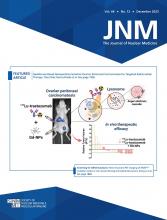AI ethics in data collection: Herington and members of the SNMMI task force on artificial intelligence identify 4 ethical risks in the use of AI in nuclear imaging and provide preliminary recommendations for mitigating impacts on patients and practice.
Page 1848
Perspective on 61Cu PET: Fani and Nicolas look at the advantages (including streamlined production, kit radiolabeling, and theranostic applications) of 61Cu-labeled radiotracers for PET and survey current challenges and alternatives.
Page 1855
PET imaging in IBD: Rezazadeh and colleagues review recent advances in PET tracers for imaging biomarkers in inflammatory bowel disease pathogenesis, such as molecules overexpressed on immune cells and cytokines that perpetuate inflammatory signaling.
Page 1858
131I-refractory thyroid carcinoma: Laschinsky and colleagues use next-generation sequencing to explore genetic alterations associated with the onset of radioiodine-refractory papillary thyroid cancer.
Page 1865
PSMA PET and response to ARPIs: Shagera and colleagues evaluate the role of PSMA PET/CT for response assessment and outcome prediction in patients with metastatic castration-resistant prostate cancer treated with androgen receptor pathway inhibitors.
Page 1869
ChatGPT and PET/CT: Rogasch and colleagues investigate the ability of an artificial intelligence chatbot to adequately answer patient questions before and after [18F]FDG PET/CT imaging in common clinical indications.
Page 1876
PET imaging of KRAS mutations: Li and colleagues report on development of a Kirsten rat sarcoma mutation oncoprotein-targeted PET tracer and assess its potential for imaging KRASG12C mutation status in non–small cell lung and colorectal cancers.
Page 1880
CXCR4 PET/CT in marginal zone lymphoma: Duell and colleagues compare the performance of C-X-C motif chemokine receptor 4–directed PET/CT with that of routine diagnostics in marginal zone lymphoma and review prospective benefits in management and in theranostic applications.
Page 1889
SSTR expression in lung NETs: Al-Toubah and colleagues characterize the degree and uniformity of somatostatin receptor expression on DOTATATE PET in patients with metastatic lung neuroendocrine tumors and discuss implications for SSTR-targeted therapy candidacy.
Page 1895
68Ga-FAPI PET/CT and NAC in breast cancer: Chen and colleagues evaluate the suitability of 68Ga–fibroblast activation protein inhibitor PET/CT for early and late prediction of pathologic response to neoadjuvant chemotherapy in breast cancer.
Page 1899
68Ga-FAPI versus 18F-FDG PET/CT staging: Demmert and colleagues compare the accuracy of PET/CT oncologic staging with 68Ga–fibroblast activation protein inhibitor and with 18F-FDG in patients with a range of tumor types.
Page 1906
68Ga-FAPI PET in PDAC: Kessler and colleagues report on the superior accuracy of fibroblast activation protein–targeted PET, including histopathologic verification, detection rates, and changes in management, in patients with pancreatic ductal adenocarcinoma.
Page 1910
177Lu-rhPSMA-10.1 versus 177Lu-PSMA-I&T dosimetry: Rinscheid and colleagues perform an intrapatient comparison of pretherapeutic dosimetry with the PSMA-targeting radiopharmaceutical 177Lu-rhPSMA-10.1 and 177Lu-PSMA-I&T in patients with metastatic castration-resistant prostate cancer.
Page 1918
RALU final analysis: Rahbar and colleagues detail the results of a multicenter retrospective study documenting 177Lu-PSMA therapy safety and efficacy in patients with metastatic castration-resistant prostate cancer previously treated with 223Ra.
Page 1925
Radium and PSMA radioligand therapy: Jadvar offers expert perspective on current data on sequential and combination therapies with 223RaCl2 and PSMA in metastatic castration-resistant prostate cancer and highlights a related article in this issue of JNM.
Page 1932
Targeted IL2 and FAP RLTs: Galbiati and colleagues study the antitumor efficacy of a combination of 177Lu-labeled radioligand therapeutics targeting the fibroblast activation protein with an antibody–cytokine fusion protein–interleukin 2 for delivery of interleukin 2 to tumors.
Page 1934
Radiotheranostic sdAb targeting FAP: Dekempeneer and colleagues describe preclinical characterization of a single-domain antibody against fibroblast activation protein α and assess SPECT and PET imaging potential and theranostic promise.
Page 1941
Theranostics targeting glypican-1: Watabe and colleagues evaluate in mice an anti–glypican-1 monoclonal antibody labeled with 89Zr or 211At for theranostic targeting of glypican-1 in pancreatic ductal adenocarcinoma.
Page 1949
Gadolinium-based nanoparticles in ovarian cancer: Garcia-Prada and colleagues investigate in a murine model of ovarian cancer whether gadolinium-based nanoparticles can increase the therapeutic efficacy of targeted [177Lu]Lu-trastuzumab.
Page 1956
[123I]CC1 therapy targeting PARP: Chan and colleagues report on preclinical studies with [123I]CC1, a radiolabeled poly(adenosine diphosphate ribose) polymerase inhibitor, for radioligand therapy in PARP-expressing cancers.
Page 1965
[18F]T-008 PET for CH24H: Constantinescu and colleagues characterize in healthy humans [18F]T-008, a PET radiotracer for imaging cholesterol 24-hydroxylase, including kinetic modeling, test–retest variability, and dose occupancy evaluation for soticlestat, a selective CH24H inhibitor for treatment of seizures.
Page 1972
[18F]PI-2620 in AD and FTLD: Blazhenets and colleagues elucidate [18F]PI-2620 binding patterns on PET in patients with suspected frontotemporal lobar degeneration and Alzheimer disease.
Page 1980
Omni Legend 32 PET/CT: Yamagishi and colleagues report on the performance characteristics of the Omni Legend 32, a PET/CT system featuring silicon photomultiplier–based detectors with bismuth germanium oxide crystals and a 32-cm axial field of view.
Page 1990
100 years of the tracer principle: Hoberück and colleagues offer a centenary overview of this key concept underpinning nuclear medicine, molecular imaging, and radiotheranostics.
Page 1998
SSTR antagonists in thyroid cancer: Enke and colleagues present a case study on [68Ga]Ga-DOTATOC PET/CT evaluation for somatostatin receptor–directed peptide receptor radionuclide therapy eligibility as an alternative to tyrosine kinase inhibition in a patient with recurrent papillary thyroid carcinoma.
Page 2001
- © 2023 by the Society of Nuclear Medicine and Molecular Imaging.







